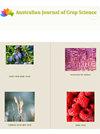The influence of tropical pasture improvement on animal performance, nitrogen cycling, and greenhouse gas emissions in the Brazilian Atlantic Forest
Q3 Agricultural and Biological Sciences
引用次数: 0
Abstract
This study evaluated beef cattle performance, nitrogen (N) dynamics, and potential greenhouse gas emissions (GHG) in tropical pastures receiving N fertilization or mixed with legumes. During the cool season, 54 Nellore heifers were randomly allotted to continuous grazing in three plots of each pasture type: T1 (Marandu grass with 150 kg N/ha), T2 (Marandu grass with 120 kg N/ha), T3 (Marandu grass with Arachis pintoi), T4 (Marandu grass with Desmodium heterocarpo), T5 (Marandu grass without N fertilization), and T6 (degraded pasture). The stocking rate was periodically adjusted to achieve the target canopy height of 20–25 cm. Animal performance and N livestock excretion were estimated by variation in live weight and spot samples of urine and feces, respectively. GHG emissions were calculated using the methodology of the Intergovernmental Panel on Climate Change. Animal performance was higher in fertilized and mixed pastures (e.g., T1 to T4) than in T5 and T6 pastures. Heifers grazing on T1, T2, T3, and T4 excreted lower amounts of urine with higher N concentrations than heifers grazing on T5 and T6. Heifers grazing in T2 and T4 pastures had a lower concentration of fecal N than those grazing on other pastures, reflecting lower N excretion in this form. The potential for direct nitrous oxide emissions per unit area in pastures mixed with legumes was approximately four times lower than that in pastures with mineral N fertilization. The recovery of degraded pastures and the inclusion of forage legumes contributed to maintaining the sustainability of animal production in pastures热带牧场改良对巴西大西洋森林动物生产性能、氮循环和温室气体排放的影响
本研究评估了施用氮肥或混合施用豆科植物的热带牧场肉牛生产性能、氮动态和潜在温室气体排放。在凉爽季节,将54头Nellore母牛随机分为3个样地连续放牧,每个样地分别为T1 (N = 150 kg /ha的马兰度草)、T2 (N = 120 kg /ha的马兰度草)、T3(马兰度草加花生)、T4(马兰度草加杂交稻)、T5(不施肥的马兰度草)和T6(退化草场)。定期调整载畜率,以达到20 ~ 25 cm的目标冠层高度。动物生产性能和氮排泄量分别通过活重变化和尿液和粪便现场样品估算。温室气体排放量的计算采用了政府间气候变化专门委员会的方法。施肥和混合放牧(如T1 ~ T4)的动物生产性能高于T5和T6牧场。放牧于T1、T2、T3和T4的犊牛排泄量低于放牧于T5和T6的犊牛,且N浓度较高。T2和T4放牧犊牛粪氮浓度低于其他放牧犊牛,反映了犊牛粪氮以该形式排泄较低。在单位面积上,豆科牧草的直接氧化亚氮排放潜力比施用矿质氮肥的牧场低约4倍。退化牧场的恢复和牧草豆科植物的种植有助于维持牧场动物生产的可持续性
本文章由计算机程序翻译,如有差异,请以英文原文为准。
求助全文
约1分钟内获得全文
求助全文
来源期刊

Australian Journal of Crop Science
农林科学-农艺学
CiteScore
1.20
自引率
0.00%
发文量
75
审稿时长
3.5 months
期刊介绍:
Information not localized
 求助内容:
求助内容: 应助结果提醒方式:
应助结果提醒方式:


